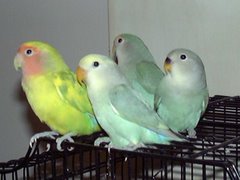How to clean the lovebirds cages?
Cleanliness is extremly important for continuous health and well being of the caged birds. Frequent cleaning is a must without stressing the lovebirds. Regular cleaning and disinfecting the lovebirds cage is an important criterion to keep them in good health. A thorough cage cleaning and disinfection should be carried out weekly.
The lovebirds in the cages should be removed and housed in another substitute cage for some time along with new perches. The cage shoud be subjected to shower, and run very hot water over them to remove excessive soiling.
The perches and toys also being cleaned under hot running water. Scrub these acessories with non-toxic and bird-friendly cleanser. Again rinse the perches and toys in the hot water and dry it before fixing the same in the cleaned cages. Even you can dry the perches in the oven for 150-300 degrees after thoroughly rinsing them.
Glutaraldehyde can be used for disinfection purpose of the cage and floor. Weekly cleaning with hot soapy and mild disinfection may be carried out. A mild disinfectant like hypo chlorate, Lysol, QAC compounds can also be used.
If you do want to remove the stubborn spots on wooden perches or small wooden toy, you can try either sand paper to remove it or odor remover or enzyme-based stain (even you can use cat urine remover).
If you are not willing to scrub the lovebirds poop, then you can use a do-it-yourself car wash. You can use it at least once in six months. You may be amazed to see the results of this method. But you should make sure that you rinsed away all the soap away. Cleaning once in seven day keeps doctor away...








 Free Ads For Bloggers
Free Ads For Bloggers

